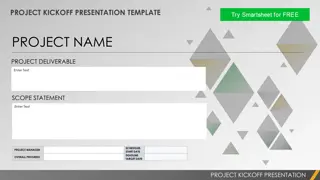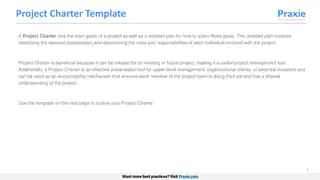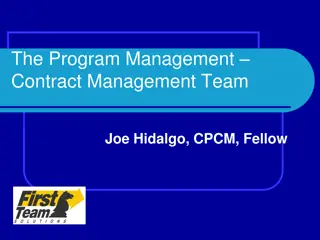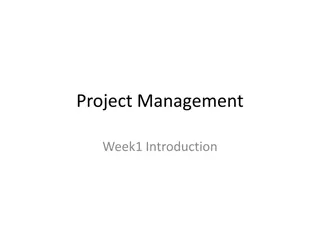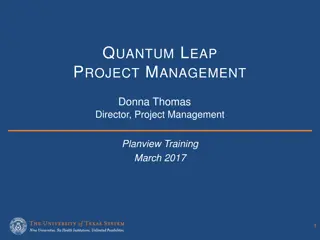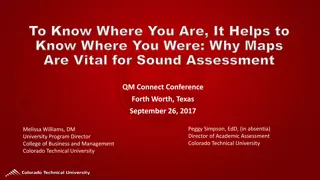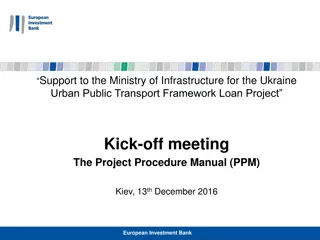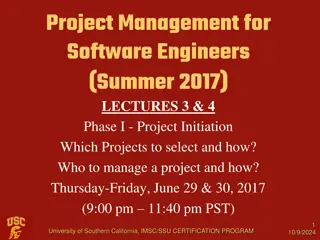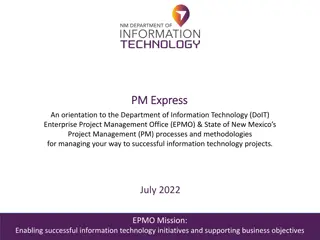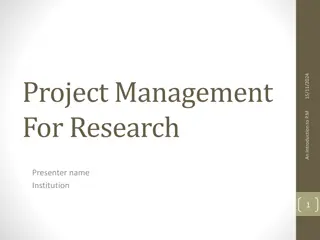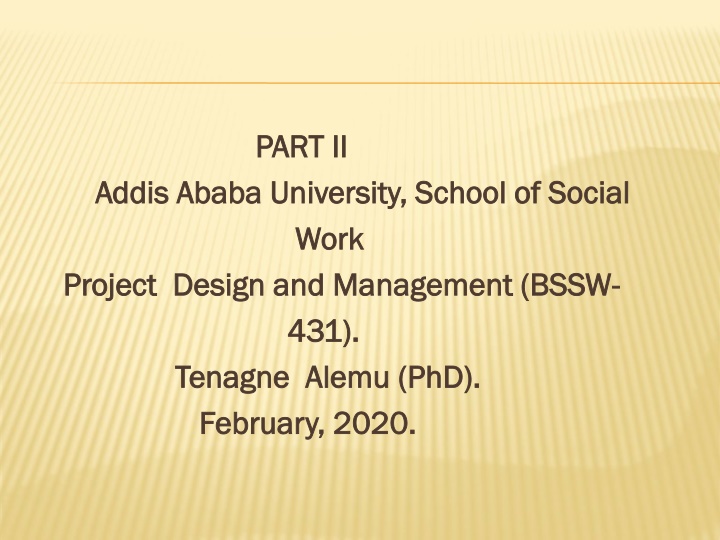
Project and Program Management
The differences between projects and programs, learn about project formulation and development, and understand the origins of projects from various sources. Discover how projects fit into broader development plans, and grasp the essential characteristics of successful project implementation.
Download Presentation

Please find below an Image/Link to download the presentation.
The content on the website is provided AS IS for your information and personal use only. It may not be sold, licensed, or shared on other websites without obtaining consent from the author. If you encounter any issues during the download, it is possible that the publisher has removed the file from their server.
You are allowed to download the files provided on this website for personal or commercial use, subject to the condition that they are used lawfully. All files are the property of their respective owners.
The content on the website is provided AS IS for your information and personal use only. It may not be sold, licensed, or shared on other websites without obtaining consent from the author.
E N D
Presentation Transcript
PART II PART II Addis Ababa University, School of Social Addis Ababa University, School of Social Work Work Project Design and Management (BSSW Project Design and Management (BSSW- - 431). 431). Tenagne Tenagne Alemu Alemu (PhD). February, 2020. February, 2020. (PhD).
Project Proposal Formulation Project Proposal Formulation
Define the distinction between a project and a program: Program Project What is a project formulation? How can we develop a project?
PROGRAM AND PROJECT What is a Project? A project is a planned undertaking of interrelated and coordinated activities designed to achieve certain specific objectives with in a given budget and period of time. It should however be , noted that there are different views and definitions of a project. However, the following few characterstics are usually common to all projects:
1. It operates within a defined objectives, activities, cost, location, target group, and expected outputs 2. It requires the commitment of scarce resources for a specific line of action, such as financial, material and manpower 3. In most cases, it involves special financial arrangements, including loans and grant from different agencies 4. It is designed to improve the socio-economic status of the targeted community
In view of the above, a project might be defined or explained as a set of organized ACTIVITIES which yield expected RESULTS RESULTS that achieve project OBJECTIVES OBJECTIVES with limited RESOURCES within a limited TIME TIME frame ACTIVITIES, RESOURCES
PRPGRAM What is a development Program/plan? It is a wider under taking which involves the implementation of several projects to attain sectoral or national objectives. Effective project preparation and analysis, therefore, must be seen in the framework of broader development plan of a country/sector or Institution. This implies that projects are part of an overall development strategy/and broader planning process, and there lies the distinction between a project and a programme.
ORIGINS OF PROJECTS Projects could originate from various sources 1. Some may be RESOURCE BASED RESOURCE BASED and stem from the opportunity to make profitable resources 2. Others may be MARKET MARKET- -BASED identified demand in home or overseas markets 3. Some may be NEED BASED NEED BASED where the purpose is to try to make available to the target community, in a defined area, minimal amount of certain basic material requirements and services. BASED arising from
What ever is the origin, the governing principles are that a project design must ensure that the proposed intervention will be technically feasible, economically viable and social and feasible, economically viable and social and culturally acceptable culturally acceptable to the intended beneficiaries. technically
INTRODUCTION TO PROJECT FORMULATION Project formulation is a systematic and logical way of developing Project formulation is a systematic and logical way of developing cost cost- -effective solutions to development problems effective solutions to development problems Ex. Think of a problem tree and identified problems, objectives and Ex. Think of a problem tree and identified problems, objectives and strategies and stakeholders respectively. This process is to strategies and stakeholders respectively. This process is to respond to the problems by addressing objectives using possible respond to the problems by addressing objectives using possible strategies together with potential stakeholders. strategies together with potential stakeholders. A proposal is a request for financial assistance to implement a A proposal is a request for financial assistance to implement a project project A proposal must justify each item in the list of things you want, so A proposal must justify each item in the list of things you want, so that a donor agency can decide to provide some or all of the that a donor agency can decide to provide some or all of the requests requests The project proposal must reflect the back ground work you have The project proposal must reflect the back ground work you have already done and should be logically set out already done and should be logically set out Remember that there will be many other organizations and Remember that there will be many other organizations and individuals competing for the fund individuals competing for the fund 10
INTRODUCTION Before beginning to write a proposal you need to keep in mind the following points: Clarify the purpose of purpose of the project Determine the broad project goals broad project goals, then identify the specific objectives objectives Identify the requirements of the grant making agency, and be certain that your project fulfils them Understand what is expected of you from the grant making- agency Request proposal guidelines, if they have Note whether there is a funding floor or ceiling specific 11
Make sure that your project plan is based on the communities needs ( baseline data, community based needs assessment results, broad community participation in identification and prioritization of needs, etc have been conducted....)
THE ANALYSIS PHASE IN RELATION TO PROJECT FORMULATION The project formulation begins by analysing the existing situation and developing objectives for addressing real needs of the community. Remember the problem identification tools in this stage) The analysis phase is the most critical , yet most difficult phase (MISTAKES AT THIS POINT WILL SPOIL EVERYTHING....) WHY? Why is mistake in analysis of problems affect the project life at large in the context of a develpoment project planning and implementation? (group work. It will be presented by group representatives) The analysis phase consists of four/three stages: 1.Problem/situation Analysis 2. Objectives analysis 3. Stakeholders Analysis and 4. strategy analysis.
THE ANALYSIS PHASE CONTI A. Problem/situation Analysis: Defin: is the process of understanding the status, trends, conditions, and key issues affecting people and people s livelihoods, ecosystems, or institutions in a given geographic context at any level ( national, regional or local) Rational for having situation analysis: 1. It helps to clearly identify the needs and concerns of beneficiaries and their livelihoods
2. It helps to develop goals, objectives, and activities that makes sense for the site s conditions 3. It helps to assess the likely consequences and implications of a project with in its wider context. (Ex. You cannot implement projects in a given community if your approach is culturally insensitive, etc) Eg. Condom Promotion in relation to religious beliefs, sexual practices, etc...
GUIDING PRINCIPLES THAT SHOULD BE FOLLOWED IN ANALYZING SITUATIONS A good situation Analysis will be: 1. Participatory- shared vision of the problem, shared strategies, etc 2. Outward looking- seeing what others are doing ( explore what is and what is not working and why?) 3. Learning from others:
METHODS AND TOOLS Some of the methods and tools for situation analysis are: Review of Back ground documents Informal meetings ( GATE KEEPERS, ,,,,,,,,) Stakeholder workshops FGD Semi-structured Interviewing Direct observation Structured Interviewing Formulating a problem identification using a problem tree analysis
BASIC STEPS 1. Define the boundaries of the area to be included in the analysis ( delineating the area). We cannot conduct analysis in bigger geographic area if we are limited in resources we have at hand. - should be participatory, using maps, descriptive statistics, -It will be easier if boundaries are determined as resources available and information is known 2. Prepare for field work- careful planning - what resources are necessary and /or available - How much time is required -Who should take part in the analysis -What knowledge will the team need
What site should the assessment team visit? ,etc 3. Select appropriate data collection methods - What methods will be used to gather relevant information? - Desk review of published statistics, literature review, etc - collection of primary data using appropriate tools and approaches
4. Research and describe the current state and conditions of people and the eco-system + Human dimension: - Health and population (physical and metal health, disease, mortality, fertility, etc) - Wealth (the economy, material goods, infrastructures, etc) - Knowledge and Culture (education, state of knowledge about people, systems of belief, etc)
. Community (rights and freedoms , peace ,crime, social order) - Equity (distribution of benefits and burdens between males and females, among ethnic) groups, and other socially disadvantaged groups - Identify and Analyze what problems and issues affect people, the eco-system and institutions in a given geographic context at any level( local, regional, national, and international contexts)
Issue analysis Issue analysis refers to the external and internal envi tl factors that are likely to have the greatest impact on the future of the project Problem Analysis Problem Analysis refers to an assessment of the major problems or concerns of the d/t stakeholders of the project 7. Analyze vision and opportunities: Vision analysis Vision analysis is the process of identifying and analysing what changes the project /program would like to bring about
8. Assess stakeholders interest, influence and importance - Stakeholders expectation of the project - the likely benefit for the different stakeholders - What resources stakeholders be able and willing to mobilize to support the project - Which stakeholders interest conflict with other stakeholders and those of the project.
PROBLEM TREE Problem tree as mechanism to conduct problem Analysis What is a problem tree? Problem tree analysis? Benefits of using problem tree as a means to a problem analysis How to form a group for a problem tree analysis Problem tree as cause-effect relationship in the problem analysis process
PROJECT IDENTIFICATION CRITERIA Discussion of a project identification criteria How to see the relationship between a problem identification and project identification
COMPONENTS OF A PROJECT PROPOSAL Project proposal development may not necessarily follow the same Project proposal development may not necessarily follow the same outline. WHY? However, for the purpose of this class, the following outline. WHY? However, for the purpose of this class, the following contents can be used to understand the contents. contents can be used to understand the contents. Proposal Title Proposal Title Cover letter Cover letter Executive Summary Executive Summary Introduction Introduction Background/project context Background/project context Problem/Need Statement Problem/Need Statement Project Goals and objectives Project Goals and objectives Project Outputs Project Outputs Methods Methods Inputs Inputs Organization and Administration Organization and Administration Monitoring and Evaluation Monitoring and Evaluation Phase out strategy and sustainability Phase out strategy and sustainability Project Budget Project Budget 1. 1. 2. 2. 3. 3. 4. 4. 5. 5. 6. 6. 7. 7. 8. 8. 9. 9. 10. 10. 11. 11. 12. 12. 13. 13. 26 14. 14.
COMPONENTS OF A PROJECT PROPOSAL 1. Proposal title keep interest of your reader in mind Make it persuasive, positive and one that will capture attention Cover letter Quickly gain the reader attention Show why the particular agency should be interested in your proposal Convey the importance and urgency of your project Keep it short Make it look good 2. 27
COMPONENTS OF A PROJECT PROPOSAL 3. Executive summary It should be clear, concise, and specific It should describe who you are, the scope, objective and expected results of your project, and the cost. 28
COMPONENTS OF A PROJECT PROPOSAL 4. Introduction In this part of the proposal you introduce your organization More often proposals are funded on the reputation of an applicant organization or its key personnel, rather than on the basis of the project s content alone The introduction is the section in which you build your credibility, and make the case that your organization should be supported. Establish credibility!!! 29
COMPONENTS OF A PROJECT PROPOSAL Other things to say in the introduction How you get started- your purpose and goals How long you have been around, how you've grown, and the breadth of your financial support Unique aspects of your agency - the fact that you were the first organization of its kind in the nation, etc. Some of your most significant accomplishments as an organization or, if you are a new organization, some of the significant accomplishments of your Board or staff in their previous roles Your success with related projects The support you have received from other organizations and individuals (accompanied by a few letters of endorsement which can be attached in the Appendix). 30
COMPONENTS OF A PROJECT PROPOSAL 5. Back ground/Project context Background information on the place where the project is going to be located It could include the geographic and climatic information, political and administrative scenario and socio-economic status, etc. Sometimes, the background information and the introduction can be systematically combined. 31
COMPONENTS OF A PROJECT PROPOSAL 6. Problem/Need Statement 6. Problem/Need Statement The problem /Need statement or situation description is a The problem /Need statement or situation description is a key step in grant proposal writing key step in grant proposal writing It is where you convince the donor that the issue you It is where you convince the donor that the issue you want to tackle is important and shows that your want to tackle is important and shows that your organization is an expert on the issue organization is an expert on the issue Use the different needs assessment tools you have learned in the Use the different needs assessment tools you have learned in the introductory sessions to understand what problem introductory sessions to understand what problem identification and problem means. identification and problem means. In developing Problem/Need Statement, consider the In developing Problem/Need Statement, consider the following points: following points: 32
PROBLEM STATEMENT Make a logical connection between your organization s background and Make a logical connection between your organization s background and the problems and the needs which you propose to work the problems and the needs which you propose to work If the problem is about water, the need should not be about education If the problem is about water, the need should not be about education Clearly define the problem(s) with which you intend to work. Make sure Clearly define the problem(s) with which you intend to work. Make sure that what you want to do is workable that what you want to do is workable- -that it can be done with a reasonable time by your agency and with a reasonable amount of reasonable time by your agency and with a reasonable amount of money. money. that it can be done with a Support the existence of the problem by evidence. Support the existence of the problem by evidence. Statistics, Statistics, statements from groups in your community concerned about the statements from groups in your community concerned about the problem, problem, from prospective clients, from prospective clients, from other organizations working in your community and from from other organizations working in your community and from professionals in the field. professionals in the field. 33
PROBLEM /NEED STATEMENT Be realistic Be realistic- -don t try and solve all the problems in the world in the don t try and solve all the problems in the world in the next six months next six months Don't assume the donor knows much about your subject area Don't assume the donor knows much about your subject area Describe why this need/situation is important Describe why this need/situation is important Describe your issue in as local context as possible or Describe your issue in as local context as possible or organization focus organization focus 34
PROBLEM ANALYSIS PROBLEM ANALYSIS Problem analysis identifies the negative aspects of an existing situation and establishes the cause and effect relationships between the problems that exist. It involves three steps: 1. Precise definition of the framework and subject of analysis; 2. Identification of the major problems faced by target Identifying the real problems of beneficiaries groups and beneficiaries (What is / are the problem/s? Whose problems?);
PROJECT PROPOSAL CONTI.. 7. Project Goals and Objectives Rules for Setting a Project Goal Rules for Setting a Project Goal . There should be only one goal per project. 2. The goal should be connected to the vision for development. 3. It is difficult or impossible to measure the accomplishment of the goal using measurable indicators, but it should be possible to prove its merit and contribution to the vision. A well prepared proposal has the continuity-a logical flow from one section to another Your introduction can establish the context of your problem statement Similarly, the problem statement will prepare the funding source for your logical goals and objectives The goal and objectives are the outcomes of the planned project, and they answer the question, how would the situation look if were changed 36
GOAL A goal is a broad statement of the ultimate result of the A goal is a broad statement of the ultimate result of the change being undertaken change being undertaken e.g. e.g. Decrease prevalence of STIs among out of school youth Increase availability of resources to address the problem of adolescent pregnancies These are not measured These are not measured Goal is a result that is some times unreachable in the short Goal is a result that is some times unreachable in the short term term Goal is often written for the organization as part of a long Goal is often written for the organization as part of a long range planning process range planning process 37
OBJECTIVES An objective is a measurable, time specific result that the organization expects to accomplish as part of the grant It is much more narrowly defined than a goal Like a goal the objective is tied to the need statement Good objectives also answer the following five simple questions: When: Time Where: Plan of action Who: Client What: Expected Outcome How much: Percentage problem is reduced 1. 2. 3. 4. 5. 38
OBJECTIVES Objective should be SMART Objective should be SMART Simple/Specific Simple/Specific- -they measure only one thing, not many different aspects of an they measure only one thing, not many different aspects of an objective. To keep them simple, break down complex objectives into several objective. To keep them simple, break down complex objectives into several sub sub- -objectives. objectives. Measurable Measurable- - objectives need to be accurately measured to be useful, but they objectives need to be accurately measured to be useful, but they should be aimed at program usefulness, not "developing new knowledge" for should be aimed at program usefulness, not "developing new knowledge" for the sake of the knowledge itself. the sake of the knowledge itself. Appropriate Appropriate- - "technically adequate" (according to current understanding and "technically adequate" (according to current understanding and practices) and "important" (it measures something that will actually reflect the practices) and "important" (it measures something that will actually reflect the success of some aspect of the program or project). success of some aspect of the program or project). Realistic Realistic - - the objectives should be set at levels that can reasonably be the objectives should be set at levels that can reasonably be attained during the specified time period. attained during the specified time period. Time Time- -bound must be clearly specified. must be clearly specified. bound - - the time frame within which the objective will be accomplished the time frame within which the objective will be accomplished 39
OBJECTIVES Examples of SMART Objectives By the end end of the project, at least 35% regular participants in the anti participants in the anti- - report that they have changed some risky behavior after learning about the risk of AIDS 35% of the AIDS clubs AIDS clubs will risky behavior Increase condom use among urban youth, ages 18 to 25, (by 20% to 25, (by 20% in the next year. next year. urban youth, ages 18 Increase reduction of sexual partners among in school youth from the current three to one by end of the project. 40
COMPONENTS OF A PROJECT PROPOSAL 9. Methods It is the part of the proposal where the reader should be able to gain a picture in his/her mind of exactly how things work to achieve the stated objectives For example one of the strategy used to achieve the objective given above is through establishing anti AIDS clubs Relevant activities might be: 41
COMPONENTS OF A PROJECT PROPOSAL 10. 10. Project Inputs Project Inputs Inputs are the financial (budgets), material (equipment, logistics) and human resources (project team, partner organizations) necessary for carrying out the activities. If the project is to be "sustainable", then the identification of key local resources is likely to be crucial to the achievement of sustainability. Human, material, financial, ( how? Remember all the participatory discussions since the situation analysis phase .) Local Resource Identification= Ownership= sustainability=riplicability Make input requirements as detailed as possible and justify any specific requirements to avoid, for example, unsatisfactory substitutions of equipment at a later stage. ( replacing what was originally in the input plan replacing what was originally in the input plan by something else by something else i.e i.e promising some material inputs or some professional promising some material inputs or some professional inputs by others which might not be comparable .). inputs by others which might not be comparable .). 42
COMPONENTS OF A PROJECT PROPOSAL Project Organization and Administration The project's internal organization as well as its relations to partner organizations have to be expressed in hierarchical and operational terms. 11. Are the collaborations with institutions or individuals, permanent or occasional, contractual or informal. Identify type of relationships..( permanent, and temporary r/sps) Indicate where the project is located; headquarters and/or decentralized units. Working relationship between staff members within organizations. Show working r/s 43
12. MONITORING AND EVALUATION 12. MONITORING AND EVALUATION What information are needed for monitoring? Who is responsible to conduct M&E, tools to conduct M&E, purposes of M&E, etc Depending on the size of the project, monitoring and evaluation could include the following information: - Who should monitor and evaluate? What to monitor and evaluate? How to monitor and evaluate? Monitoring and evaluation indicators Resource requirements,
EVALUATION Evaluation is an assessment, as systematic and objective as possible, of an ongo-ing or completed project, programme or policy, its design, implementation and results. The aim is to determine the relevance and fulfilment of objectives, develop-mental efficiency, effectiveness, impact and sustainability. An evaluation should pro-vide information that is credible and useful, enabling the incorporation of lessons learned into the decision-making process of both recipients and donors
An evaluation can be done during implementation (mid-term), at its end (final evaluation) or afterwards (ex post evaluation), either to help steer the project or to draw lessons for future projects and programming. Ex ante evaluationrefers to studies during the preparatory phases of the project cycle (pre- feasibility or feasibility studies).
MAJOR PRINCIPLES OF EVALUATION Impartiality & independence of the evaluation process in its function from the process concerned with policy making, the delivery and management of assistance ( separation of evaluation and responsibility for the project/ programme/policy) Credibility depending on expertise and independence of the evaluators & transparency to be sought through an open process, wide availability of results, distinction between findings and recommendations Usefulness: relevant, presented in a clear and concise way, reflecting the interests and needs of the parties involved, easily accessible, timely and at the right moment improved decision-making Participation of stakeholders (donor, recipient...); if possible: views and expertise of groups affected should form integral part of the evaluation; Involving all parties
TYPES OF EVALUATIONS TYPES OF EVALUATIONS Evaluations can take place: Evaluations can take place: when the project is still under way: such interim evaluation are usually under-taken at mid-term (mid-term evaluation), to review progress and propose alterations to project design during the remaining period of implementation; 2. at the end of a project (final or end of project evaluation), to document the resources used, results and progress towards objectives. The objective is to generate lessons about the project which can be used to improve future de- signs; 3. a number of years after completion (ex post evaluation), often focusing on impact.
EVALUATION CRITERIA EVALUATION CRITERIA Relevance : Relevance : objectives to the problems that it was supposed to address, and to the physical and policy environment within which it operated, and including an assessment of the quality of project preparation and design. The logic and completeness of the project planning process, and the internal logic and coherence of the project design can be seen through evaluation. The appropriateness of project
Efficiency : Efficiency : achieved at reasonable cost, i.e. how well inputs/means have been converted into results, in terms of quality, quantity and time, and the quality of the results achieved. This generally requires comparing alternative approaches to achieving the same outputs, to see whether the most efficient process has been adopted. The fact that the results have been





